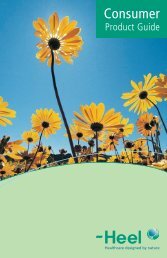allergy indications - Heel BHI
allergy indications - Heel BHI
allergy indications - Heel BHI
You also want an ePaper? Increase the reach of your titles
YUMPU automatically turns print PDFs into web optimized ePapers that Google loves.
inTroducTion<br />
Allergies pose major health problems. Not only does<br />
disease-like allergic rhinitis affect 20 to 40 million people<br />
annually, it also results in an accumulative 3.8 million<br />
lost work and school days. The wide coverage of anti-<br />
allergic medicine in the media and on supermarket shelves<br />
also alludes to the widespread impact of this condition.<br />
The allergic response<br />
Allergy represents an inappropriate reaction of an organism to a mostly innocuous<br />
substance. Allergens could be seasonal, such as mold, grasses, trees and pollens, as<br />
well as perennial (through the year), such as dust mites and animal dander. Irritants, like<br />
cigarette smoke and diesel exhaust fumes may promote the allergic response, but are not<br />
allergens in themselves. It is important to note that for the immune system to develop an<br />
allergic response, the substance needs to possess a peptide sequence or an amino acid<br />
sequence.<br />
Why is the immune system so vulnerable today?<br />
As with the development of all diseases, the development of allergies depends on three<br />
factors: genetic predisposition, environmental influences and a trigger.<br />
The genetic predisposition has been well studied in patients with allergies. Experiments<br />
conducted in the 1920’s already showed that if two parents were allergic, 50% of their<br />
offspring would be allergic, and even if one parent was allergic, 30% of thier offspring<br />
stood a chance to be allergic.<br />
The effects of environmental toxins have been mentioned, but it is also important to note<br />
that allergic mediators, such as histamine, are internal toxins and are cleared from the<br />
system through liver detoxification. If the liver is overloaded, or missing certain important<br />
co-factors, the patient will not be able to remove the histamine from the system, and<br />
will have more symptoms of <strong>allergy</strong>. If certain immunotoxic chemicals are not cleared<br />
from the body, and are stored in the matrix, they can contribute to an abnormal immune<br />
response. Detoxification and support of the detoxifying organs is an integral part of the<br />
homotoxicological approach to <strong>allergy</strong>.<br />
The cytokine environment in the tissues is also of special importance. It is well recognized<br />
now that patients with allergies have an immune response which, on a cellular level, is<br />
skewed towards a certain reaction, namely a TH2 response.<br />
Normally, T-helper cells circulate as T-0 cells, and depending on which antigen it is<br />
presented with (via the antigen presenting cells such as macrophages and dendritic cells)<br />
it will develop into a TH1 cell, TH2 or a TH3 cell (Figure 2).<br />
Fig. 1: The allergic response.<br />
Dust Mite<br />
The incidence of <strong>allergy</strong> is increasing and numerous factors have been postulated for<br />
this. People living in urban areas are more prone to allergic disease. Environmental<br />
factors, such as diesel exhaust fumes, and especially sulfur dioxide, as well as<br />
ozone and overcrowding have all been implicated in allergic disease. Environmental<br />
toxins like sulfur dioxide not only predispose the immune system to <strong>allergy</strong>, but also<br />
change the quality of the nasal mucosa so that it has a hyper-responsiveness towards<br />
allergens. It may also change the structure of an antigen-like pollen so that it becomes<br />
more allergenic.<br />
These cells secrete different<br />
messengers called cytokines,<br />
which will then generate the<br />
appropriate immune response.<br />
In the case of a virus or fungal<br />
infection, a TH1 response is<br />
preferred. TH1 will generate a<br />
cellular immune response via the<br />
secretion of the cytokines IFN<br />
gamma, Tumor Necrosis Factor<br />
IL-2<br />
IFN gamma<br />
TNF<br />
Inflammation<br />
DHEA<br />
TGF-ß<br />
Inhibition<br />
Cortisol<br />
IL-4, 13<br />
IL-5<br />
IL-10<br />
Allergy<br />
(TNF), and IL-1 to kill these invaders. Antibodies are made when TH2 cells are stimulated,<br />
as TH2 cells will activate plasma cells. The TH2 cells secrete other cytokins Interleukin 4, 5,<br />
10, and 13, apart from other cytokins. These cytokines are closely involved in the allergic<br />
response, as Interleukin 4 and 13 induce IgE formation, Interleukin 5 enhances the growth<br />
of eosinophils and Interleukin 10 promotes mast cell growth (See also the Immunology of<br />
Allergy).<br />
TH3 helper cells are regulatory T-cells and secrete mainly a cytokine called Transforming<br />
Growth Factor beta (TGF-ß), which is an anti-inflammatory that facilitates tissue repair, and<br />
may be able to restore the balance between TH1 and TH2.<br />
In healthy individuals there is a small daily oscillation between TH1 and TH2 cells, so that<br />
the body is always ready to respond in a certain fashion. It is a well known fact that allergic<br />
patients are slanted towards a TH2 response. Some patients are born with this skewed<br />
response, especially if they are allergic from birth. This means that the immune system<br />
will easily go down the TH2 pathway in response to antigens, and cause allergic reactions<br />
more easily.<br />
Fig. 2: TH1/TH2 balance.<br />
In Homotoxicology, we call this skewed response “regulation rigidity” and we should<br />
endeavor to restore the normal physiological oscillations between TH1 and TH2 cells.<br />
Traumeel has been shown to down regulate the pro-inflammatory cytokines, and to<br />
increase TGF-ß, and it is postulated to induce TH3 cells.



